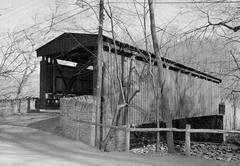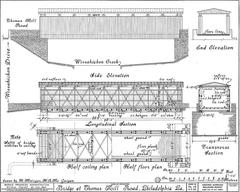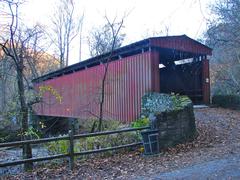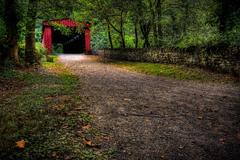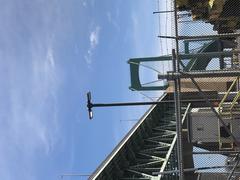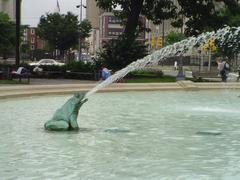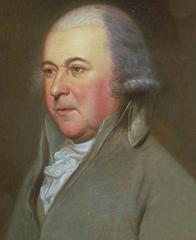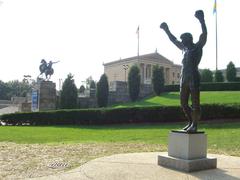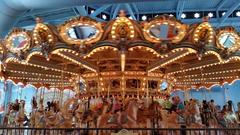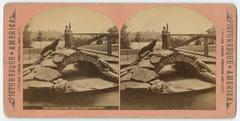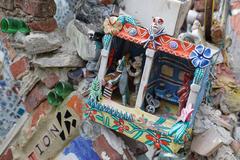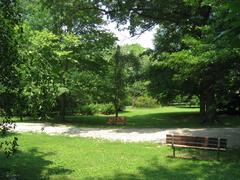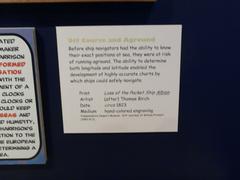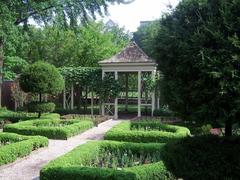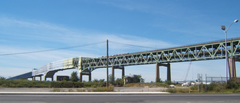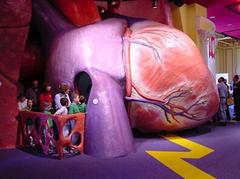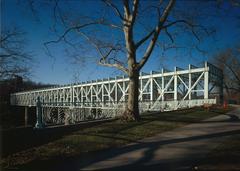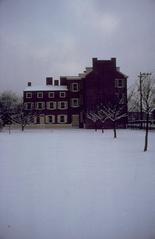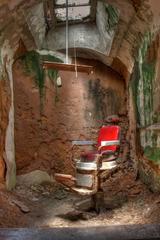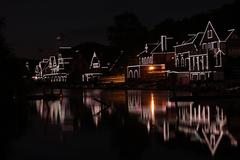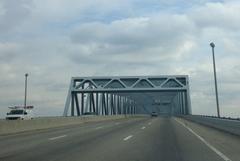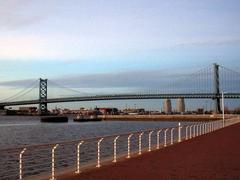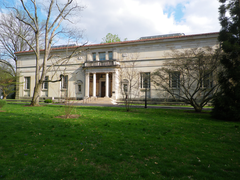
Visiting Thomas Mill Road Bridge in Philadelphia: History, Tips, and Visitor Information
Date: 01/08/2024
Introduction
Nestled in the scenic Wissahickon Valley Park in Philadelphia, the Thomas Mill Covered Bridge stands as a unique historical landmark. Constructed in 1855, this bridge is the only remaining covered bridge in Philadelphia and one of the few urban covered bridges in the United States. Spanning 86.5 feet over the Wissahickon Creek, the bridge is a testament to 19th-century engineering and has been preserved through various conservation efforts (Wikipedia). The bridge is a single-span Howe truss design, known for its strength and simplicity, and features traditional wooden planks and stone abutments (Waymarking). Over the years, the Thomas Mill Covered Bridge has undergone several renovations, including a significant restoration in 1999 funded by the Fairmount Park Commission, which included a $420,000 rehabilitation project (Living New Deal). Recognized for its historical and architectural significance, the bridge was listed on the National Register of Historic Places on December 1, 1980 (Wikipedia). Today, it serves as a beloved landmark in Wissahickon Valley Park, providing a scenic route for pedestrians and cyclists, and offering a glimpse into Philadelphia’s rich industrial past (Uncovering PA).
Table of Contents
- [Historical Background](#historical-backgroundhistorical-background)
- [Architectural Features](#architectural-featuresarchitectural-features)
- [Renovations and Restorations](#renovations-and-restorationsrenovations-and-restorations)
- [National Register of Historic Places](#national-register-of-historic-placesnational-register-of-historic-places)
- [Cultural and Historical Significance](#cultural-and-historical-significancecultural-and-historical-significance)
- [Role in the Community](#role-in-the-communityrole-in-the-community)
- [Visiting Hours](#visiting-hoursvisiting-hours)
- [Ticket Information](#ticket-informationticket-information)
- [Accessibility](#accessibilityaccessibility)
- [Preservation Efforts](#preservation-effortspreservation-efforts)
- [Visitor Experience](#visitor-experiencevisitor-experience)
- [Nearby Attractions](#nearby-attractionsnearby-attractions)
- [FAQ](#faqfaq)
- [Conclusion](#conclusionconclusion)
- [References](#referencesreferences)
Historical Background
The Thomas Mill Covered Bridge, also known as the Thomas Mill Road Covered Bridge, is a historic wooden bridge located in Wissahickon Valley Park, Philadelphia. This bridge is notable for being the only remaining covered bridge in Philadelphia and the only covered bridge in a major American city. The bridge was originally constructed in 1855 and spans 86.5 feet over the Wissahickon Creek (Wikipedia).
Architectural Features
The Thomas Mill Covered Bridge is a single-span Howe truss bridge, a design that was popular in the 19th century for its strength and simplicity. The bridge measures 86.5 feet in length and 18.66 feet in width. It features traditional wooden planks set in a crosswise pattern and stone abutments at either end, which support the structure (Waymarking).
Renovations and Restorations
The bridge has undergone several renovations to preserve its historical integrity. The first major restoration was carried out in 1939 by the Works Progress Administration (WPA), a New Deal agency that provided jobs during the Great Depression (Living New Deal). Another significant renovation took place in 1999, funded by the Fairmount Park Commission, which included a $420,000 rehabilitation project. This project involved installing a new stainless steel roof, deck, siding, and repairing the beams at each of the four corners at the abutments (Waymarking).
National Register of Historic Places
In recognition of its historical and architectural significance, the Thomas Mill Covered Bridge was listed on the National Register of Historic Places on December 1, 1980. This designation helps ensure the bridge’s preservation and acknowledges its importance as a historical landmark (Wikipedia).
Cultural and Historical Significance
The Thomas Mill Covered Bridge is not just a piece of architectural history; it also holds cultural significance. It is a contributing property of the Chestnut Hill Historic District, which is known for its rich history and well-preserved 19th-century architecture. The bridge serves as a tangible link to Philadelphia’s past, offering a glimpse into the city’s industrial era when the Wissahickon Valley was a bustling center of activity (Waymarking).
Role in the Community
Today, the Thomas Mill Covered Bridge is a beloved landmark in Wissahickon Valley Park. It is open to pedestrian and bicycle traffic, providing a scenic route for visitors exploring the park. The bridge’s picturesque setting, surrounded by lush greenery and the tranquil Wissahickon Creek, makes it a popular spot for photography and leisurely walks (Uncovering PA).
Visiting Hours
The Thomas Mill Covered Bridge is accessible to visitors year-round. As it is located within Wissahickon Valley Park, the park’s hours of operation generally apply. The park is open from dawn to dusk, offering ample opportunity for visitors to explore the bridge and its surroundings.
Ticket Information
There is no entrance fee to visit the Thomas Mill Covered Bridge. The bridge and the surrounding park are free to the public, making it an affordable and accessible attraction for everyone.
Accessibility
The Thomas Mill Covered Bridge is accessible via several trails in Wissahickon Valley Park. The most popular routes start from Bells Mill Road, and the hike to the bridge is relatively short, taking about 10 minutes from the nearest parking area. The trails are well-maintained, making it easy for visitors of all ages and fitness levels to reach the bridge.
Preservation Efforts
Preservation of the Thomas Mill Covered Bridge is crucial to maintaining its historical and cultural significance. The bridge’s inclusion in the National Register of Historic Places and its status as a contributing property of the Chestnut Hill Historic District help protect it from potential threats such as vandalism and natural decay. Additionally, ongoing maintenance and community support play vital roles in ensuring the bridge remains a cherished landmark for future generations (Living New Deal).
Visitor Experience
Visiting the Thomas Mill Covered Bridge offers a unique opportunity to step back in time and experience a piece of Philadelphia’s history. Visitors can enjoy the serene surroundings, explore nearby trails, and take in the beauty of the Wissahickon Creek (The Outbound).
Nearby Attractions
The area around the Thomas Mill Covered Bridge is rich with other historical and natural attractions. Visitors can explore the Tedyuscung Statue, Houston Meadow, and the Wissahickon Gorge, all of which offer additional opportunities for hiking, photography, and enjoying the natural beauty of the park. The Wissahickon Gorge, in particular, is known for its stunning scenery and historical significance, making it a must-visit destination for nature enthusiasts and history buffs alike (Uncovering PA).
FAQ
What are the visiting hours for Thomas Mill Covered Bridge?
The bridge is accessible during the park’s hours of operation, which are from dawn to dusk.
Is there an entrance fee to visit the Thomas Mill Covered Bridge?
No, there is no entrance fee. The bridge and the surrounding park are free to the public.
What are some nearby attractions?
Nearby attractions include the Tedyuscung Statue, Houston Meadow, and the Wissahickon Gorge, all of which offer opportunities for hiking, photography, and enjoying the natural beauty of the area.
Conclusion
The Thomas Mill Covered Bridge is more than just a historical structure; it is a symbol of Philadelphia’s rich heritage and a gateway to the city’s natural beauty and cultural significance. Its preservation efforts, including its listing on the National Register of Historic Places, ensure that this architectural marvel remains a cherished landmark for future generations (Wikipedia). Visitors to the bridge can enjoy not only the scenic views and historical ambiance but also explore nearby attractions such as the Wissahickon Gorge, Valley Green Inn, and the various trails within Wissahickon Valley Park (Uncovering PA). Whether you are a history enthusiast, a nature lover, or simply seeking a peaceful retreat, the Thomas Mill Covered Bridge offers a unique and enriching experience. Plan your visit today and immerse yourself in the beauty and history of this Philadelphia gem. For more information and updates on historical sites in Philadelphia, download the Audiala mobile app and follow us on social media.
